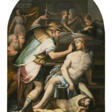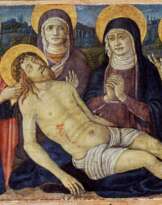Giorgio Vasari (1511 - 1574)

Giorgio Vasari
Giorgio Vasari, polymath of the Italian Renaissance, left an indelible mark on painting, architecture, and art history. Born on July 30, 1511, in Arezzo, Italy, Vasari was deeply influenced by the patronage of the Medici family during his artistic education in Florence. Exposure to the works of Andrea del Sarto and the profound influence of Michelangelo's work shaped his development as an artist and architect. Vasari's artistic career was characterized by his contributions throughout Italy, including significant works in Florence and Rome, and his role in founding the Florentine Academy and the Society of the Fine Arts in 1563 underscores his commitment to art and education.
Vasari's architectural skill is evident in the design of the Uffizi Loggia in Florence, testifying to his ability to combine functionality with aesthetic grandeur, creating a space that harmonizes with the urban landscape while blending into the riverside environment. His contribution extends to the Vasari Corridor, an architectural marvel that connects the Uffizi to Palazzo Pitti across the Arno River, demonstrating his innovative approach to public and private space.
Perhaps Vasari's most enduring legacy stems from his seminal work, Lives of the Most Excellent Painters, Sculptors, and Architects, in which he outlined biographies of Renaissance artists, laying the foundation for the discipline of art history. This work not only elevated the status of artists in society, but also created a history of the development of art that emphasizes the Renaissance as a period of rebirth and innovation. Vasari's narratives, although their accuracy is sometimes criticized, remain a cornerstone in the study of Renaissance art, offering invaluable insights into the lives and works of the era's most prominent figures.
Vasari's work is represented in prominent museums and galleries, including the Minneapolis Institute of Arts and the National Gallery of Art, which houses important works such as the Six Tuscan Poets and works commissioned by the Pope. His architectural and artistic contributions, combined with his innovative historiographical approach, have cemented his reputation as a key figure of the Renaissance and the annals of art history.
Giorgio Vasari's multifaceted contributions to painting, architecture, and art history not only underscore his genius, but also play a key role in shaping our understanding of the Renaissance. His works and writings continue to inspire collectors, experts, and enthusiasts. For those seeking to delve deeper into the world of Renaissance art and Vasari's profound influence, subscribing to updates on new sales and auction events related to Vasari can offer a wealth of information and the opportunity to explore his enduring legacy.
| Date and place of birt: | 30 july 1511, Arezzo, Italy |
|---|---|
| Date and place of death: | 27 june 1574, Florence, Italy |
| Nationality: | Italy |
| Period of activity: | XVI century |
| Specialization: | Architect, Artist, Painter, Researcher, Writer |
| Art school / group: | Guild of Saint Luke |
| Genre: | History painting, Portrait, Religious genre |
| Art style: | Mannerism, Renaissance, Old Masters |
| Technique: | Fresco |

































